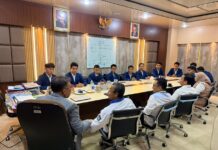Erdi Suroso
Head of Environmental Research and Development Center of Unila
LAMPUNG Province covers 35,288.35 km2 of land area with sea area estimated around 24,820 km2. Meanwhile, the coastline areas: West Coast (221 km), Semaka Bay (200 km), Lampung Bay and Sunda Strait (160 km), and East Coast (270 km).
Lampung has seven coastal areas namely Pesisir Barat, Tanggamus, Pesawaran, Bandar Lampung, South of Lampung, East of Lampung and Tulangbawang.
Mining activities are strategic activities for a region in improving the industrial and economic sectors. Sea sand mining is one of the activities in coastal areas. The mining carried out around the coast or can also be done in the middle of the sea, either with traditional or modern tools.
According to Presidential Decree No. 33 of 2002, sea sand is an excavation material that is found in all coastal and marines of Indonesia, which is not classified as a class A and / or B according to its economic terms, and sea sand is one of the non-renewable natural resources.
However, sea sand mining is still permissible according to the existing laws and regulations if it is carried out in accordance with the provisions and regulations of sea sand mining. Even so, it is still done illegally or violates the regulations.
The Law of the Republic of Indonesia No. 32 of 2009, article 36 Paragraph (1) requires every business or analysis of the environmental impact (Amdal) to have an environmental permit. The permit is for activities that are required Amdal or environmental management efforts (UKL)- efforts to monitor the environment (UPL)- in the context of environmental protection and management as a prerequisite for obtaining a business license.
Sea sand mining is prohibited as regulated in the Law of the Republic of Indonesia No. 27 of 2007 and revised by Law of the Republic of Indonesia No. 1 of 2014 concerning Management of Coastal Areas and Small Islands. In the article 35 states that sand mining is prohibited if it can damage the aquatic ecosystem.
In article 35 paragraph (1), it states that sand mining in areas which technically, ecologically, socially and/or culturally causes environmental damage and/or pollution and/or harms the surrounding community, and also violates article 109 of the Law of Republic of Indonesia no. 32 of 2009 concerning Environmental Management.
Besides, Lampung Province also has a Regional Regulation No. 1 of 2018 concerning Zoning Plan for Coastal Areas and Small Islands (RZWP3K) of Lampung in 2018-2038, which regulates spatial planning on the coast and small islands, so that the designation becomes clear. Whether for tourism, marine and fisheries designation, used for ESDM designation, forestry designation, or others.
Fishermen’s Fate
One of the fire incidents of a ship by the community in the coastal area of Labuhanmaringgai Subdistrict, East Lampung Regency, which allegedly owned by the company, took place on Saturday, March 7, 2020. It was an expression of refusal from the community to the sea sand exploitation
The refusal of fishermen communities is part of the struggle to strengthen their constitutional rights. The right for the environment and good and healthy waters, also to consider the sustainability of the lives of fishermen.
The Sekopong Island coastal community, Syahbandar waters, and surrounding areas also refuse the plan. It will damage the fishing areas of the coastal area of East Lampung Regency, destruct the ecosystem of carb cultivation, and potentially submerge Sekopong Island.
Based on article 66 of the Law of the Republic of Indonesia No. 32 of 2009 concerning Environmental Protection and Management (UU PPLH) states that anyone who fights for the right to a good and healthy environment cannot be prosecuted criminally or civilly sued.
The explanation of this article is to protect victims or whistleblowers who resort to legal methods due to environmental pollution and damage. This is to prevent retaliation from being reported through criminal prosecution or civil lawsuits.
The Impact of Illegal Mining
The negative impact obtained from illegal sea sand mining cause the damage to the marine ecosystem for a long time and takes time to recover it. Some of the obvious negative impacts of sea sand mining are as follows:
(1) Increase coastal abrasion and erosion.
(2) Reducing the quality of the marine and coastal environment.
(3) Coastal pollution increased
3) Declining the quality of seawater which causes turbid seawater increasingly
(4) Destruct fish spawning areas.
(5) Cause turbulence that increases in levels of suspended solids in the seabed.
(6) Increase the intensity of tidal floods, especially in coastal areas where there is sea sand mining.
(7) Destruct the ecosystem of the coral reef and marine life.
(8) The higher wave hits the coast or sea because the bottom of the sea becomes very steep and deep. The wave will go higher to the shoreline because of reduced damping by the bottom of the coastal sea.
(9) The emergence of social conflicts between pro-environment communities and sea sand miners.
From the explanation, it is time for the regional government specifically in charge of sea sand mining to review the regulation. Sea sand mining has two opposing sides, it is improving the welfare and quality of life of people and on the other hand, this can cause damage to the environment and coastal and marine ecosystems.
Alternative Steps
The alternative steps to regulate and limit the mining are as follows:
(1) The regional government, especially Lampung should have periodically determined and reviewed regional regulations on sea and coastal spatial planning with all relevant elements.
(2) Review the environmental and mining business license (IUP) for exploitation of sea sand mining areas and adjusted to the Local Government Regulation of Lampung No. 1 of 2018 concerning the Zoning Plan for Coastal Areas and Small Islands (RZWP3K) of Lampung in 2018-2038.
(3) Sea sand mining companies coordinate with stakeholders in the Labuhan Maringgai District to seek alternatives for developing economic sectors of the communities, such as crab cultivation, brackish water fisheries, giant prawns and others. This is the way to improve their lives and welfare. (4) Increase the mangrove tree planting program.
(5) Revoke mining business lisence (IUP) of sea sand mining explotation that has been violated by companies that and prohibit illegal mining by making binding legal regulations with maximum fines.
(6) Socialization of the benefits of mangrove forests to protect coastal and marine ecosystems.
(7) Supervise the coast and the sea by the competent and lisenced authority










